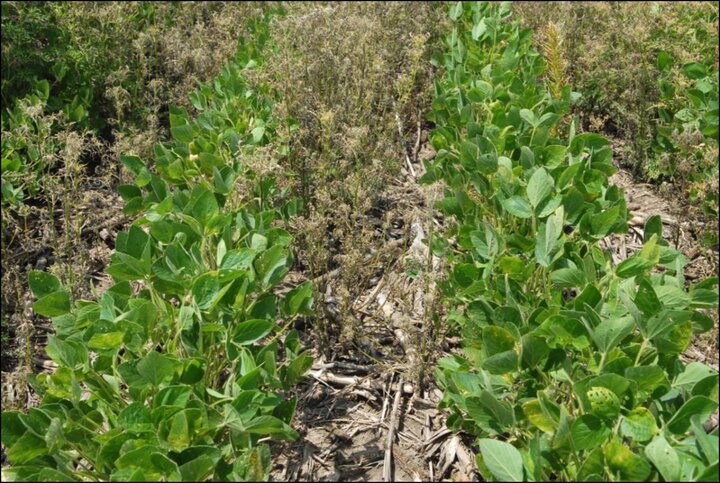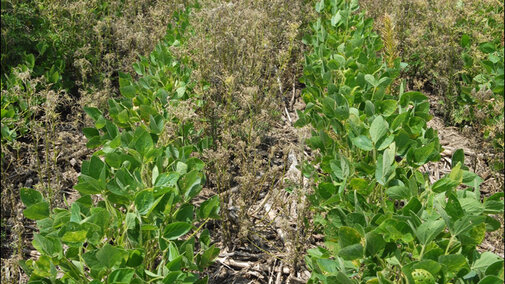In the last two decades glyphosate has been used extensively throughout the Midwest for broadleaf and grass weed control in glyphosate-resistant corn and soybean cropping systems. Its popularity stemmed from its broad-spectrum effectiveness after the introduction of glyphosate-resistant crops in the late 1990s. Its low cost and flexibility in application timing encouraged widespread adoption and use.
Reliance on glyphosate as the primary method of weed control rather than as part of an integrated strategy using several weed control options has allowed for the selection of glyphosate-resistant weeds. Common ragweed, common waterhemp, giant ragweed, marestail, kochia, and Palmer amaranth have been confirmed glyphosate-resistant in Nebraska. With glyphosate no longer an option for the control of these glyphosate-resistant weed populations, growers are looking for herbicides with different modes of action. A diversified herbicide program for weed management needs to be used to avoid evolving resistance to multiple modes of action. A diversified herbicide program should include at least two effective modes of action in each application and should rotate modes of action between years to keep selection pressure low.

Figure 2. Optill (2 oz/acre) tank-mixed with Outlook (21 fl oz/acre) applied preplant. Photo was taken seven days after herbicide application.
Nebraska Research

A field study was conducted in 2015 and 2016 near Adams where glyphosate-resistant common ragweed was first confirmed to evaluate herbicide programs for the control of glyphosate-resistant common ragweed in LibertyLink (glufosinate-resistant) soybean. Glyphosate-resistant common ragweed can be controlled effectively by using a diversified preplant and POST herbicide program in LibertyLink soybean.
Common ragweed has an early spring emergence period in Nebraska with 90% total emergence reached before mid-May. This necessitates using a preplant burndown herbicide to control emerged common ragweed before planting (Figure 1).
- Herbicide options such as 2,4-D, Authority First, Optill plus Outlook, paraquat, Sharpen plus 2,4-D, or Valor XLT effectively controlled common ragweed before planting and up to three weeks after application (Figure 2).
- Liberty applied post-emergence alone or in a tank-mixture with Prefix, Pursuit, or Warrant controlled 84%-98% glyphosate-resistant common ragweed (Figure 3).
- For best control and to reduce the evolution of herbicide resistance no single mode of action should be used preplant or post-emergence.
- Single applications (only preplant or only POST) resulted in less weed control, greater weed biomass, and less soybean yield.
- Three applications (preplant, pre-emergence, late post-emergence or preplant, early post-emergence, late post-emergence) did not result in greater common ragweed control, weed biomass reduction, or soybean yield (Figure 4 and 5).


The cost of preplant followed by post-emergence herbicide programs ranged from $59.17 to $93.09 per acre with application and provided the highest gross profit margins compared to no weed control and single- or triple-application herbicide programs (Table 1).
- Single application herbicide programs were cheapest but resulted in much less profit due to low soybean yield.
The pre-plant/pre-emergence/post-emergence program provided equal control of glyphosate-resistant common ragweed as the pre-plant/early-post/late-post-emergence program.
Learn More
More details about glyphosate-resistant common ragweed control in LibertyLink soybean can be found in a paper recently published in Frontiers in Plant Science.
| Herbicide Program | Program cost a | Gross revenue b,c | Gross profit margin d |
|---|---|---|---|
| -------------- $/acre --------------- | |||
| Preplant: Optill [2 oz/acre] + Outlook [21 fl oz/acre ] | 79.88 | 284.64 | 204.76 |
| Post-emergence: Liberty [36 fl oz/acre] | |||
| Preplant: Authority First [6.4 oz/acre] | 72.93 | 253.51 | 180.58 |
| Post-emergence: Liberty [36 fl oz/acre] | |||
| Preplant: Valor XLT [5 oz/acre] | 68.12 | 250.21 | 182.09 |
| Post-emergence: Liberty [36 fl oz/acre] | |||
| Preplant: 2,4-D [2.1 pt/acre] | 59.17 | 250.48 | 191.31 |
| Post-emergence: Liberty [36 fl oz/acre] + [Pursuit 4 oz/acre] | |||
| Preplant: Gramoxone Inteon [4 pt/acre] | 71.35 | 245.2 | 173.85 |
| Post-emergence: Liberty [36 fl oz/acre] + Classic [0.75 oz/acre] | |||
| + Warrant [2 qt/acre] | |||
| Preplant: Sharpen + 2,4-D (preplant) | 93.09 | 278.96 | 185.87 |
| Post-emergence: Liberty [36 fl oz/acre] + Warrant [2 qt/acre] | |||
| Preplant: Valor XLT (preplant) | 104.36 | 264.19 | 159.83 |
| Early post-emergence: Liberty [29 fl oz/acre] + Prefix [2 pt/acre] | |||
| Late post-emergence: Liberty [29 fl oz/acre] + Warrant [1.5 qt/acre] | |||
| Preplant: 2,4-D [2.1 pt/acre] | 81.04 | 271.71 | 190.67 |
| Pre-emergence: Authority MTZ [18 oz/acre] | |||
| Post-emergence: Liberty [36 fl oz/acre] | |||
| A Required herbicide adjuvants and application cost ($7.33 per application) were included in program cost. B The average dryland soybean yield was 30 bu per acre for above herbicide programs in 2015 and 2016. C An average soybean price of $8.87 per bushel was used to calculate gross revenue. D Gross profit margin was calculated as gross revenue-program cost. | |||

